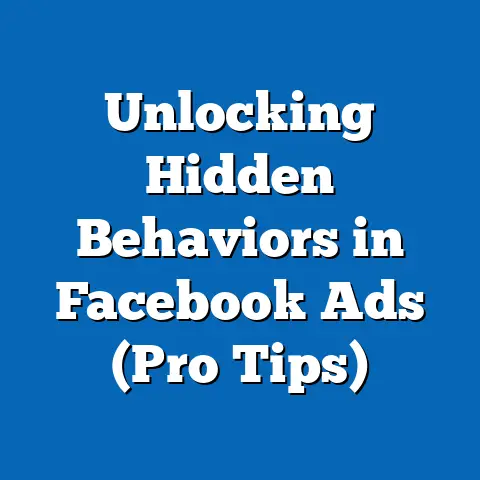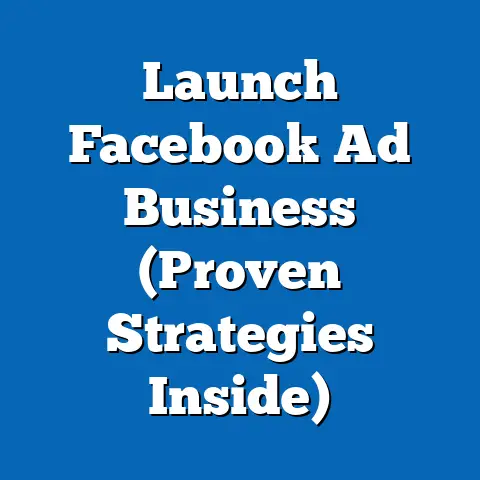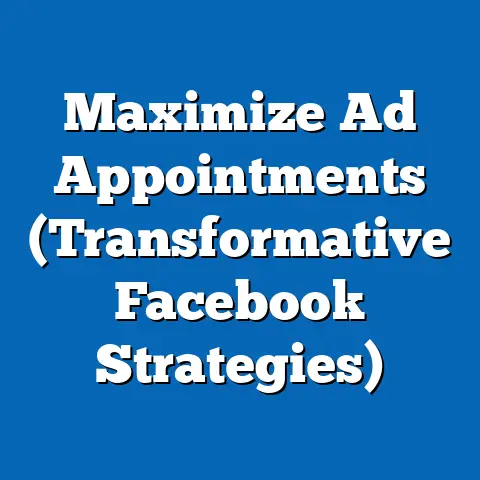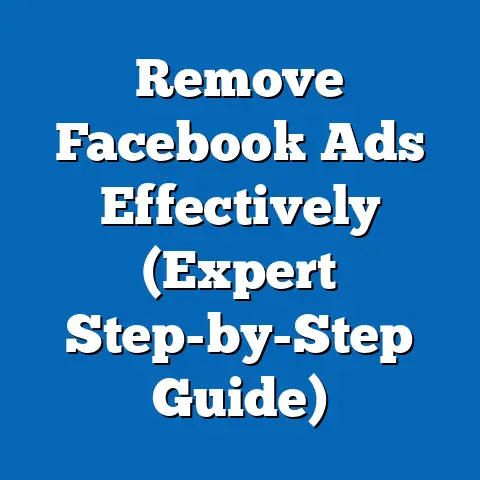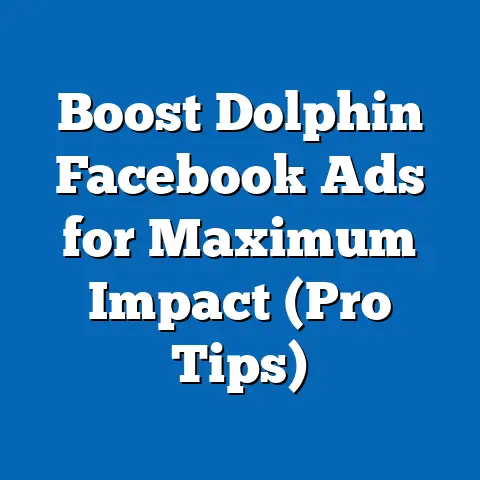Dominate Facebook Ads in 2025 (Proven Strategies Unveiled)
The digital advertising landscape is evolving, and one of the most significant shifts I’m seeing is the rising importance of eco-friendly marketing strategies. Consumers are increasingly conscious of sustainability and environmental impact, and frankly, they’re voting with their wallets. Many now actively prefer brands that prioritize eco-friendly practices. As a digital marketer, I’ve seen firsthand how businesses that embrace sustainability in their messaging and operations not only attract more customers but also build stronger brand loyalty.
Facebook Ads, with its vast reach and sophisticated targeting capabilities, is a powerful tool for reaching this environmentally-aware audience. However, simply running ads isn’t enough. To truly succeed, you need a strategy that aligns with the values of your target audience and demonstrates a genuine commitment to sustainability.
In this article, I’ll unveil proven strategies that will help you dominate Facebook Ads in 2025. These strategies will not only help you thrive in the competitive advertising landscape but also resonate with eco-conscious consumers, building a brand that is both successful and sustainable. Let’s dive in!
Understanding the 2025 Landscape
Looking ahead to 2025, I anticipate several key changes in the Facebook Ads platform that will significantly impact how we approach advertising. These changes include algorithm updates, shifts in user behavior, and the introduction of enhanced ad formats.
Algorithm Updates: Facebook’s algorithm is constantly evolving, and I expect it to become even more sophisticated in the coming years. The platform will likely prioritize ads that provide a positive user experience, which means that ads that are relevant, engaging, and non-intrusive will perform better. This shift will require advertisers to focus on creating high-quality content that genuinely resonates with their target audience, rather than relying on clickbait or deceptive tactics.
User Behavior Shifts: As consumers become more digitally savvy, their expectations for advertising are also changing. I believe they’ll demand greater transparency, authenticity, and personalization. They’ll also be more likely to engage with brands that align with their values, including their environmental concerns. This means that businesses will need to demonstrate a genuine commitment to sustainability in their advertising and marketing efforts.
Enhanced Ad Formats: Facebook is always experimenting with new ad formats, and I expect to see even more innovative options in the future. I’m particularly excited about the potential for interactive ads, augmented reality (AR) ads, and shoppable ads. These formats offer new ways to engage with consumers and drive sales. For example, an AR ad could allow users to virtually try on a product before making a purchase, while a shoppable ad could allow them to buy a product directly from the ad without leaving the Facebook app.
Implications for Businesses and Ad Strategists: These changes will have significant implications for businesses and ad strategists. To succeed in 2025, advertisers will need to:
- Focus on quality over quantity: Create high-quality content that is relevant, engaging, and non-intrusive.
- Prioritize personalization: Tailor your ads to the specific interests and needs of your target audience.
- Embrace transparency: Be honest and upfront about your brand’s values and practices.
- Experiment with new ad formats: Explore the potential of interactive ads, AR ads, and shoppable ads.
- Stay informed: Keep up-to-date with the latest changes in the Facebook Ads platform and adapt your strategies accordingly.
The Growing Trend Towards Personalized and Targeted Advertising: I’ve noticed that personalized and targeted advertising is no longer just a best practice; it’s becoming an expectation. Consumers are bombarded with ads every day, so they’re more likely to tune out ads that aren’t relevant to their interests. By targeting your ads to specific demographics, interests, and behaviors, you can increase the likelihood that your ads will be seen by people who are actually interested in your products or services.
Ecological concerns will play a significant role in shaping consumer preferences. People are increasingly seeking out brands that are committed to sustainability, ethical sourcing, and environmental responsibility. As I mentioned earlier, if your brand can credibly demonstrate that it aligns with these values, you’ll have a significant advantage in the marketplace.
Takeaway: The Facebook Ads landscape in 2025 will be shaped by algorithm updates, user behavior shifts, and enhanced ad formats. Advertisers need to focus on quality, personalization, transparency, and experimentation to succeed. Ecological concerns will increasingly influence consumer preferences, making it crucial for brands to demonstrate a genuine commitment to sustainability.
Eco-Friendly Brand Positioning
Positioning your brand as eco-friendly is crucial for attracting and retaining customers who value sustainability. I’ve seen many businesses transform their brand image by highlighting their environmental initiatives, and the results are often remarkable.
Communicating Your Brand’s Commitment to Sustainability: The key is to communicate your brand’s commitment to sustainability in a clear, authentic, and compelling way. Here are some techniques I recommend:
- Highlight your environmental initiatives: Showcase your efforts to reduce your carbon footprint, conserve resources, and protect the environment. This could include using recycled materials, reducing waste, investing in renewable energy, or supporting environmental organizations.
- Be transparent about your sourcing and production processes: Provide detailed information about where your products come from and how they’re made. This will help build trust with consumers who want to know that your products are ethically and sustainably sourced.
- Use eco-friendly packaging: Switch to packaging that is made from recycled materials, biodegradable, or compostable. This is a tangible way to demonstrate your commitment to sustainability and reduce your environmental impact.
- Partner with environmental organizations: Collaborate with reputable environmental organizations to support their work and raise awareness about environmental issues. This can help boost your brand’s credibility and demonstrate your commitment to making a positive impact.
- Get certified: Obtain certifications from recognized organizations that verify your sustainability practices. This will provide independent validation of your claims and help build trust with consumers.
Examples of Successful Eco-Friendly Brands on Facebook: I’ve observed that several brands have successfully positioned themselves as eco-friendly on Facebook, attracting a loyal following of environmentally-conscious consumers.
- Patagonia: Patagonia is a well-known outdoor apparel company that has a long-standing commitment to environmental sustainability. Their Facebook page features stories about their environmental initiatives, such as their efforts to reduce waste, conserve water, and protect wild places. They also use their page to promote their products that are made from recycled materials or organic cotton.
- Seventh Generation: Seventh Generation is a leading manufacturer of eco-friendly cleaning and household products. Their Facebook page features tips on how to live a more sustainable lifestyle, as well as information about their products that are made from plant-based ingredients and packaged in recycled materials. They also use their page to advocate for environmental policies and raise awareness about environmental issues.
- Allbirds: Allbirds is a footwear company that makes shoes from sustainable materials, such as merino wool and eucalyptus trees. Their Facebook page features images and videos of their sustainable manufacturing processes, as well as stories about their commitment to reducing their environmental impact. They also use their page to promote their products that are designed for comfort and sustainability.
The Power of Storytelling: I’ve found that storytelling is a powerful tool for connecting with consumers on environmental issues. By sharing stories about your brand’s sustainability journey, you can create an emotional connection with your audience and inspire them to take action.
- Share stories about your employees: Highlight the people who are working to make your brand more sustainable. This will help humanize your brand and show consumers that you’re not just paying lip service to sustainability.
- Share stories about your customers: Feature customers who are using your products or services to live a more sustainable lifestyle. This will help inspire other consumers to follow suit and demonstrate the positive impact of your brand.
- Share stories about your environmental initiatives: Tell the story behind your efforts to reduce your carbon footprint, conserve resources, and protect the environment. This will help consumers understand why you’re committed to sustainability and how your efforts are making a difference.
Takeaway: Positioning your brand as eco-friendly on Facebook involves communicating your commitment to sustainability in a clear, authentic, and compelling way. Highlight your environmental initiatives, be transparent about your sourcing and production processes, use eco-friendly packaging, partner with environmental organizations, and get certified. Use storytelling to connect with consumers on environmental issues and inspire them to take action.
Crafting Compelling Ad Creatives
Visually appealing and eco-conscious ad creatives are essential for capturing the attention of your target audience and communicating your brand’s sustainability message. In my experience, ads that are visually engaging and aligned with environmental values tend to perform significantly better.
Designing Ads That Highlight Sustainability: Here are some tips on designing ads that highlight sustainability:
- Use green color palettes: Green is often associated with nature, sustainability, and environmental friendliness. Using green color palettes in your ads can help convey your brand’s commitment to sustainability.
- Use eco-friendly imagery: Use images and videos that depict nature, renewable energy, sustainable practices, and other eco-friendly themes. This will help create a visual connection with your target audience and reinforce your brand’s sustainability message.
- Use transparent messaging about sourcing and production processes: Be upfront about how your products are made and where they come from. This will help build trust with consumers who want to know that your products are ethically and sustainably sourced.
- Showcase your eco-friendly packaging: Highlight your use of recycled materials, biodegradable packaging, or compostable packaging. This is a tangible way to demonstrate your commitment to sustainability and reduce your environmental impact.
- Focus on the benefits of your eco-friendly products: Emphasize the health, environmental, and social benefits of your products. This will help consumers understand why they should choose your products over conventional alternatives.
The Effectiveness of Video Content: I’ve seen that video content is particularly effective for communicating sustainability messages. Videos can be used to showcase your environmental initiatives, highlight your sustainable manufacturing processes, and share stories about your brand’s commitment to sustainability.
- Create videos that showcase your environmental initiatives: Show consumers what you’re doing to reduce your carbon footprint, conserve resources, and protect the environment.
- Create videos that highlight your sustainable manufacturing processes: Show consumers how your products are made using sustainable materials and practices.
- Create videos that share stories about your brand’s commitment to sustainability: Tell the story behind your brand’s commitment to sustainability and inspire consumers to take action.
- Create videos that feature your customers: Showcase customers who are using your products or services to live a more sustainable lifestyle.
Incorporating Video into Eco-Friendly Advertising Strategies: Here’s how you can incorporate video into your eco-friendly advertising strategies:
- Use video ads on Facebook: Facebook offers a variety of video ad formats that can be used to reach your target audience.
- Create a video series: Create a series of videos that tell the story of your brand’s commitment to sustainability.
- Use video to promote your eco-friendly products: Showcase the benefits of your eco-friendly products in a video ad.
- Use video to share customer testimonials: Feature customers who are using your products or services to live a more sustainable lifestyle.
Takeaway: Crafting compelling ad creatives that are visually appealing and eco-conscious is essential for capturing the attention of your target audience and communicating your brand’s sustainability message. Use green color palettes, eco-friendly imagery, transparent messaging, and showcase your eco-friendly packaging. Video content is particularly effective for communicating sustainability messages.
Targeting the Right Audience
Advanced targeting options on Facebook Ads are essential for reaching eco-conscious consumers. In my experience, the more precise your targeting, the higher the ROI of your ad campaigns.
Demographic Targeting: Demographic targeting allows you to reach consumers based on their age, gender, location, education, income, and other demographic characteristics.
- Target consumers who are interested in environmental issues: You can target consumers who have expressed an interest in environmental issues, such as sustainability, conservation, and renewable energy.
- Target consumers who live in eco-friendly communities: You can target consumers who live in communities that are known for their commitment to sustainability.
- Target consumers who have a high level of education: Studies have shown that consumers with a higher level of education are more likely to be concerned about environmental issues.
- Target consumers who have a high income: Consumers with a higher income are more likely to be able to afford eco-friendly products.
Interest Targeting: Interest targeting allows you to reach consumers based on their interests, hobbies, and activities.
- Target consumers who are interested in sustainable living: You can target consumers who are interested in sustainable living, such as organic gardening, composting, and reducing waste.
- Target consumers who are interested in outdoor activities: You can target consumers who are interested in outdoor activities, such as hiking, camping, and kayaking.
- Target consumers who are interested in healthy living: You can target consumers who are interested in healthy living, such as organic food, natural remedies, and exercise.
Custom Audiences: Custom audiences allow you to target consumers who have already interacted with your brand, such as website visitors, email subscribers, and social media followers.
- Create a custom audience of website visitors: You can create a custom audience of people who have visited your website and shown an interest in your products or services.
- Create a custom audience of email subscribers: You can create a custom audience of people who have subscribed to your email list and are interested in receiving updates about your brand.
- Create a custom audience of social media followers: You can create a custom audience of people who follow your brand on social media and are engaged with your content.
The Role of Data Analytics: I’ve found that data analytics plays a crucial role in refining audience targeting and improving ad performance. By tracking the performance of your ads, you can identify which targeting options are most effective and make adjustments accordingly.
- Track the performance of your ads: Monitor the number of impressions, clicks, conversions, and other key metrics to assess the performance of your ads.
- Analyze your audience data: Use Facebook’s analytics tools to analyze your audience data and identify trends and patterns.
- Refine your targeting options: Based on your data analysis, refine your targeting options to reach the most relevant and engaged consumers.
- A/B test your ads: Experiment with different targeting options and ad creatives to see what works best.
Takeaway: Targeting the right audience on Facebook Ads is essential for reaching eco-conscious consumers. Use demographic targeting, interest targeting, and custom audiences to reach the most relevant and engaged consumers. Data analytics plays a crucial role in refining audience targeting and improving ad performance.
Measuring Success and Ad Optimization
Tracking the effectiveness of your Facebook ad campaigns focused on eco-friendliness requires careful monitoring of key performance indicators (KPIs). In my experience, regularly analyzing these metrics and making data-driven adjustments can significantly improve your ROI.
Key Performance Indicators (KPIs): Here are some key performance indicators (KPIs) to track:
- Reach: The number of unique people who saw your ad.
- Impressions: The number of times your ad was displayed.
- Click-Through Rate (CTR): The percentage of people who clicked on your ad after seeing it.
- Conversion Rate: The percentage of people who completed a desired action (e.g., made a purchase, signed up for a newsletter) after clicking on your ad.
- Cost Per Acquisition (CPA): The cost of acquiring a new customer through your ad campaign.
- Return on Ad Spend (ROAS): The amount of revenue generated for every dollar spent on your ad campaign.
- Engagement Rate: The percentage of people who interacted with your ad (e.g., liked, commented, shared).
- Brand Awareness: The extent to which your ad campaign increased awareness of your brand among your target audience.
- Environmental Impact: Measuring the environmental impact of your products or services and communicating this to your audience.
Utilizing Facebook’s Analytics Tools: I strongly recommend utilizing Facebook’s analytics tools to assess the impact of your ads. Facebook provides a wealth of data that can help you understand how your ads are performing and identify areas for improvement.
- Facebook Ads Manager: This tool provides a comprehensive overview of your ad campaigns, including key metrics such as reach, impressions, clicks, conversions, and cost.
- Facebook Analytics: This tool provides insights into your audience’s demographics, interests, and behaviors.
- Facebook Pixel: This tool allows you to track conversions on your website and measure the effectiveness of your ad campaigns.
Strategies for Continual Optimization: Continual optimization of campaigns based on performance data is crucial for maximizing your ROI.
- A/B Testing: Experiment with different ad creatives, targeting options, and bidding strategies to see what works best.
- Audience Feedback: Monitor comments and reviews to understand how your audience is responding to your ads.
- Data-Driven Adjustments: Make adjustments to your campaigns based on the data you’re collecting.
- Keep Up-to-Date: Stay informed about the latest changes in the Facebook Ads platform and adapt your strategies accordingly.
Takeaway: Measuring success and optimizing your Facebook ad campaigns focused on eco-friendliness requires tracking key performance indicators (KPIs), utilizing Facebook’s analytics tools, and continually optimizing your campaigns based on performance data. A/B testing and audience feedback are essential for identifying areas for improvement.
Conclusion
As we move towards 2025, I truly believe that integrating eco-friendly practices into Facebook Ads strategies is not just a trend, it’s a necessity. Businesses that prioritize sustainability alongside effective advertising techniques will not only dominate the market but also contribute positively to society and the environment.
I encourage you to begin implementing these strategies in your own campaigns to lead the charge in eco-friendly advertising. By doing so, you’ll not only attract more customers and build a stronger brand but also make a positive impact on the world.
Don’t wait until 2025 to start. Begin today, and let’s create a more sustainable future together, one ad campaign at a time. Take the first step now by auditing your current Facebook ad strategy and identifying areas where you can incorporate eco-friendly practices. Your brand, your customers, and the planet will thank you for it.

